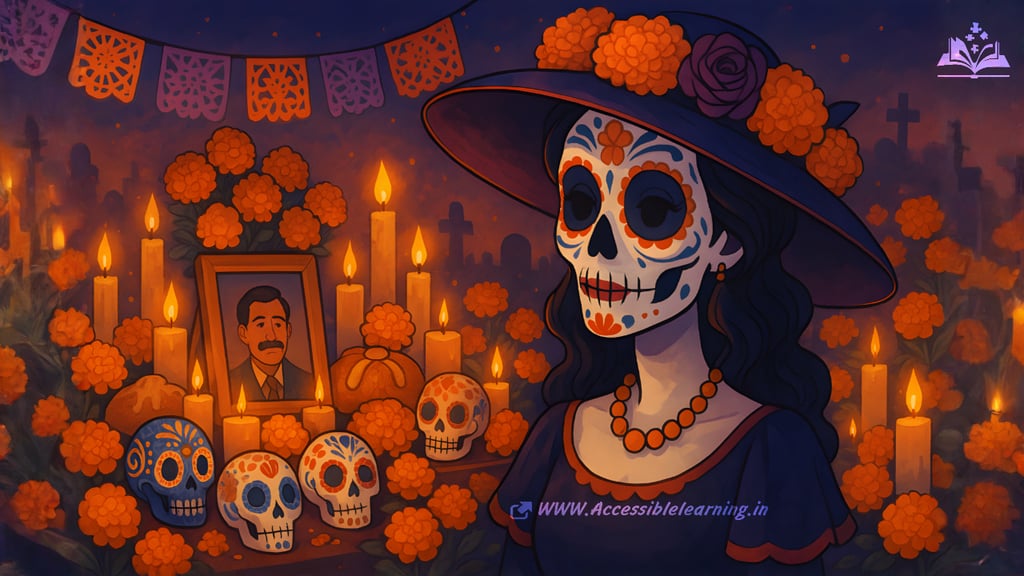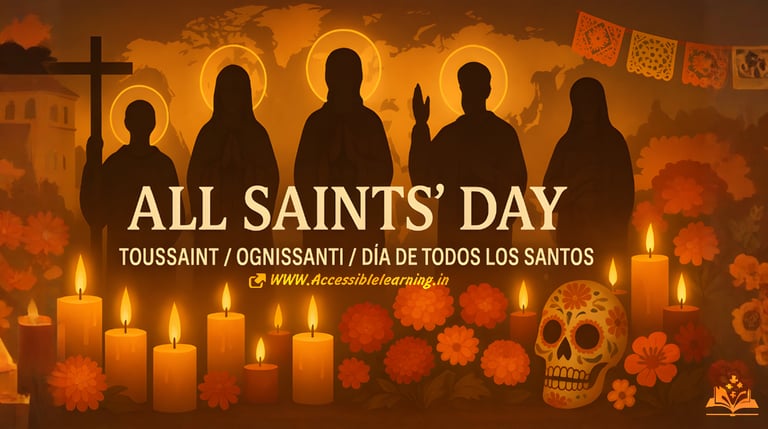
Día de Muertos (Day of the Dead): Mexico’s Eternal Bridge Between Life and Death
Explore the true essence of Día de Muertos (Day of the Dead)—Mexico’s colorful celebration of life, remembrance, and spiritual renewal. Learn its origins, traditions, rituals, and the timeless meaning behind this world-renowned festival.
EVENT/SPECIALUSACELEBRATION/FESTIVALS
Kim Shin
10/26/20255 min read


When the Living Dance with the Dead
Each autumn, as the world turns quiet and the days shorten, Mexico bursts into color. Streets glow with marigolds, candles flicker through the night, and laughter echoes from cemeteries. This is Día de Muertos, the Day of the Dead—one of the world’s most beautiful traditions, where death isn’t feared but embraced as part of life’s natural cycle.
For families, it’s not just a ritual—it’s a reunion. They believe that once a year, the souls of loved ones return home, guided by scent, light, and love, to share in familiar joys once more.
Origins: The Ancient Soul of Día de Muertos
The origins of this celebration go deep into Mesoamerican history, long before Spanish colonization. Civilizations like the Aztecs, Toltecs, and Nahuas viewed death as a continuation rather than an end.
They believed in the journey to Mictlán, the underworld—a realm ruled by Mictecacihuatl (Lady of the Dead) and her husband, Mictlantecuhtli. For them, the dead were not gone; they simply existed in another form, waiting for the right time to reconnect.
When Spanish missionaries arrived, they introduced Catholic feasts—All Saints’ Day (Nov 1) and All Souls’ Day (Nov 2). Over time, these merged with native traditions, creating a hybrid spiritual celebration that reflected both indigenous reverence and Catholic remembrance.
Timeline: The Three Sacred Days
October 31 – The Eve of Spirits:
Families begin preparing altars and cleaning cemeteries. It’s said the gates between the worlds start to open at midnight.November 1 – Día de los Angelitos (Day of the Little Angels):
This day honors the souls of children, who are believed to return first because of their innocence and purity. Families offer milk, toys, sweets, and miniature pan de muerto.November 2 – Día de los Difuntos or Día de los Muertos:
The main celebration for adults. It’s filled with music, feasts, fireworks, and cemetery vigils that last until dawn.
These three days are seen as a spiritual journey—one that connects generations and brings comfort to the living.
The Ofrenda: An Altar of Memory and Meaning
No Día de Muertos is complete without the ofrenda (altar). Each family builds one in their home, at gravesides, or in public spaces—decorated with a mix of traditional and personal touches.
A complete ofrenda typically includes seven levels, symbolizing the stages of the afterlife. Here’s what each component represents:
Marigolds (Cempasúchil): Known as the “flower of the dead,” their bright orange petals form paths that guide souls home.
Copal incense: Used by ancient priests, it purifies the space and wards off evil spirits.
Candles: One for each soul, illuminating their path.
Pan de muerto: A round loaf topped with bone-shaped designs, representing the circle of life and death.
Photos of the deceased: To identify and invite specific souls.
Water and salt: Water quenches the thirst of traveling souls; salt preserves their essence.
Personal belongings and food: Favorite dishes or objects to make the spirits feel at home.
The ofrenda is not about worship—it’s an act of remembrance, a bridge built with love.
Regional Traditions Across Mexico
While the spirit of Día de Muertos is shared nationwide, each region expresses it differently:
Oaxaca: Families spend nights in cemeteries, surrounded by candles and music. Streets host sand tapestry competitions, made with colored sand and flower petals.
Michoacán (Island of Janitzio): The Purépecha people light thousands of candles on boats, creating a glowing lake procession.
Puebla: Ofrendas feature bread baked in the shape of angels or animals, symbolizing the return of souls.
Yucatán (Hanal Pixán): The Mayan version of the celebration, translating to “Food for the Souls,” features local delicacies like mucbipollo (a large tamale cooked underground).
Mexico City: Hosts a grand Day of the Dead Parade, filled with giant skeletons, traditional dancers, and floats—now one of the city’s biggest cultural events.
Each local expression is unique, but the message is universal: death is not the end, but a transformation.
Symbols and Art: The Beauty of Death
The imagery of Día de Muertos—skulls, skeletons, and bright colors—may look macabre to outsiders, but in Mexico, it’s an affirmation of life.
Calaveras (Skulls): Made of sugar or clay, they represent the sweetness of existence.
La Catrina: Created by illustrator José Guadalupe Posada and popularized by Diego Rivera, she is an elegant skeleton lady symbolizing that even the wealthy face death equally.
Papel picado: Intricately cut tissue paper hung around altars and streets, representing the fragility of life.
Masks and face painting: People paint half their faces as skulls, symbolizing the balance between life and death.
Art and death intertwine beautifully here—turning mourning into a masterpiece of celebration.


Food and Offerings: A Feast for the Souls
The Day of the Dead is as much about flavor as it is about faith. Every meal carries symbolic meaning:
Tamales: Represent sustenance and warmth.
Atole and champurrado: Traditional drinks made from corn and chocolate, served hot during night vigils.
Calaveritas de azúcar: Sugar skulls decorated with bright icing, sometimes labeled with names.
Mole: A rich sauce made with chili and chocolate, often prepared for ancestors who loved it in life.
Fruit, water, and salt: Represent purity, nourishment, and the journey’s essentials.
Families eat these dishes together, sharing stories and laughter—keeping their loved ones alive through memory.
Spiritual Depth: Death as a Teacher
Beyond the rituals, Día de Muertos carries a philosophical message. It invites people to reflect on mortality not as loss, but as connection. Death, in this view, teaches gratitude—to cherish the present and to honor those who shaped it.
For many Mexicans, it’s also an act of resistance against forgetting. In a fast-changing world, it’s a reminder that memory is sacred and heritage is living.
Modern Times: From Local Roots to Global Recognition
In 2008, UNESCO declared Día de Muertos an Intangible Cultural Heritage of Humanity, praising its ability to unite art, faith, and family. Thanks to films like Coco (2017) and global celebrations, the festival now inspires communities worldwide—from Los Angeles to Madrid.
However, many Mexicans emphasize cultural respect: it’s not just a costume or party. To celebrate it meaningfully, one must understand its spiritual intent—remembrance and love.
Fun Fact: The Butterfly Connection
The monarch butterfly holds a special place in Día de Muertos lore. Each year, millions of them migrate to Michoacán around late October. Locals believe these butterflies carry the souls of departed ancestors, returning home with the wind.
It’s nature’s poetry in motion—a reminder that even in silence, the dead speak.
Fascinating Facts about Día de Muertos
The holiday can be traced back over 3,000 years to pre-Columbian civilizations.
The Cempasúchil flower only blooms during this season, making it a perfect natural symbol.
The typical altar has four elements represented: earth (food), water, fire (candles), and air (papel picado).
Some towns build community altars for people who died anonymously or in tragedies.
Modern art installations now use digital ofrendas—online memorials to remember loved ones virtually.
FAQ's
Q: Why are marigolds so important in Día de Muertos?
Because their color and scent are believed to attract the souls of the dead, guiding them back to the living world.
Q: What’s the meaning behind La Catrina?
She represents equality in death and satirizes social pretensions—reminding everyone that death spares no one.
Q: How do people celebrate in cemeteries?
Families clean graves, decorate them with flowers, play music, eat, and even tell jokes—turning mourning into a celebration of life.
Q: Can the Day of the Dead be celebrated outside Mexico?
Yes, but with cultural respect—focus on remembrance, not costume or aesthetics alone.
Q: What emotions define Día de Muertos?
Joy, nostalgia, gratitude, and connection—a mix that honors the cycle of life.
Subscribe to our newsletter
All © Copyright reserved by Accessible-Learning
| Terms & Conditions
Knowledge is power. Learn with Us. 📚


